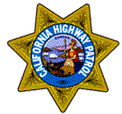

CHP RADIO SYSTEMS
PART 4
1988-2000
THE 1988 GE RADIO FLEET
(Note: Because this equipment is still in use, the photos and more details are found on my separate web page called CHP 2001 described below)
GE RANGR RADIO:
In 1987, the CHP began the evaluation process for the purchase of new radios. RCA had already exited the land mobile radio business, which left a choice of Motorola or GE. For reasons known only to those who made the purchasing decisions, but mainly because they were willing to design a "special for CHP" control head and were also the low bidder, the contract this time went to GE (later Ericsson-GE). GE supplied their RANGR 100 Watt low band mobile radio, with the series S810 alpha-numeric display integrated control head, which is still in use. It would take more than two years to completely replace the existing radio fleet with the new GE equipment, which was for the most part not retrofitted into existing vehicles in the field. Thus, in 1990, for example, there were a few area offices still using the older Micor mobiles and original GE MVR-16 repeaters in their vehicles. The RANGR equipment began to be phased into the fleet in very late 1988 and probably wasn't fully integrated until perhaps late 1990. It appears that the Mustang cars were the last to get the RANGR equipment; there are examples of new 1989 Mustangs leaving the assembly line with the older Motorola Micor equipment.
The contract for this GE equipment was:
Contract No. 1-88-58-30, Dated April 20, 1988
Purchase Order # 40041, July 29, 1988
This contract was for car and motorcycle radios, the control heads, and presumably the newer GE Executive II "mobile extenders.
The RANGR mobile radio was manufactured in Japan by JRC, to a GE design which is basically a copy of their Delta-SX USA-made radio, and then merely labeled "GE". Apparently the "Buy American" policy in place at State of California purchasing overlooked this issue. It was developed specifically for the CHP but has since found widespread use in other agencies and on other frequency bands. It is small, rugged and reliable, mounted in a cast metal frame. It is synthesized and programmable; the frequency storage and all personality aspects of the radio are contained in the "smart" control head. The GE control head also controls the siren/PA equipment via a number of TTL-level data lines and there is a serial data output which controls the emergency lighting via a separate control box located in the vehicle trunk. There is a mobile repeater as in the previous generation of radios, although in this case it is a newer generation of the original GE Executive II MVR which had a redesigned and modernized logic section, but was otherwise identical in appearance to the originals. The model number is RVR-16HS and it was apparently made only for CHP. That repeater has now in turn been (to some extent) replaced by a Pyramid Communications repeater, made in Huntington Beach, California. The motorcycles, starting in 1996, were also equipped with a mobile repeater, but in that case it consisted of a modified GE MP-A series portable radio mounted in a small box with a voltage dropping circuit to allow it to run from 12 volts. The M-PA is software programmable and in this case has been specially programmed to act as a "simplex" repeater. These are still in use as of 2012 but are being phased out.
The S810 RANGR control head was developed by GE specifically for the CHP but later redesigned as a "stock" "over the counter" item, re-numbered S825, and called the "System" control head by GE. The CHP version contains older and completely different firmware, as well as a different rubber keypad overlay, but it is actually, in a way, more versatile than the "off the shelf" S825 head. There have been at least three versions of the overlay supplied to the CHP. The RANGR is also used on motorcycles, but with the simpler head numbered S815, which GE refers to as their "scan" version S820 control head in the "off the shelf" model. The S815 does not have the lighting control right-hand keypad buttons as used on the S810. When the majority of the motorcycles began to be equipped with the M-PA vehicular repeater mentioned above, that repeater was attached to the top of the RANGR radio, which required a spacer under the top lid of the white fiberglass weather housing as supplied by GE. The current BMW cycles use a streamlined radio housing made and supplied by BMW, which does not require a spacer, and the GE housings last used on the Kawasaki KZ1000's have been retired and surplused.
The GE Rangr CHP equipment can be programmed by either the TQ-2310 "Suitcase" programmer, or the first generation TQ- series interface box although the earliest software appears to have only been available via the suitcase programmer. Also, the interface box cable must be modified to function on the CHP heads and the software is not the same as it is for the conventional S820 and S815. In both cases, only the S810 or S815 control heads are programmed. The radio drawer itself is then programmed by the control head each time the head is powered up or a new bank of channels is selected.
The standard RANGR radio drawer as purchased contains this model number:
AXA9HHTR-139B
19C852050P 8 Rev D
This would be the first generation RANGR drawer unit, 100 Watts, sometimes called "Rangr 050."
Photos and information on the GE 1988 mobile radios can also be found here: CHP 2001
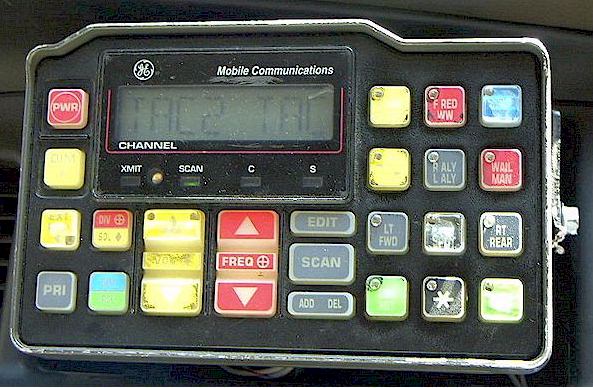
The silicone panel overlays for these heads have been revised at least twice during their lifetime in order to accommodate the "Vision" Federal light bars and the "Signalmaster" light sets,
Older overlay:
Newer generation overlay, in use sometime after 1998:
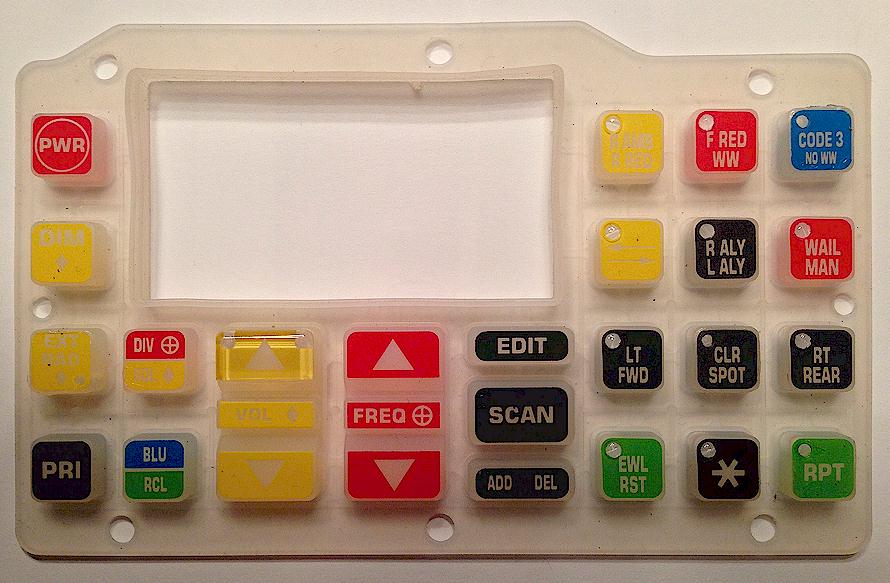
The photos below are of a trunk of a CHP Crown Victoria in 2001, but are essentially the same as would have been found in a 1988 vehicle except for the lighting controller unit, which from 1988-1992 was the Code 3 model.:
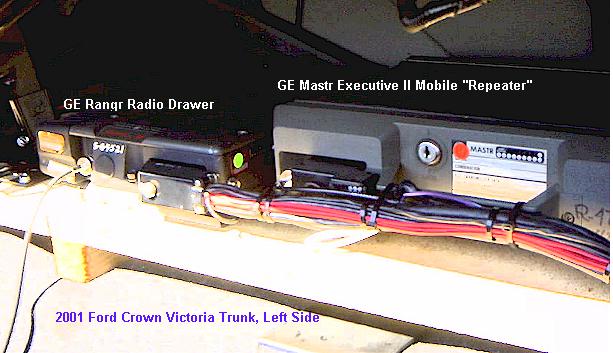
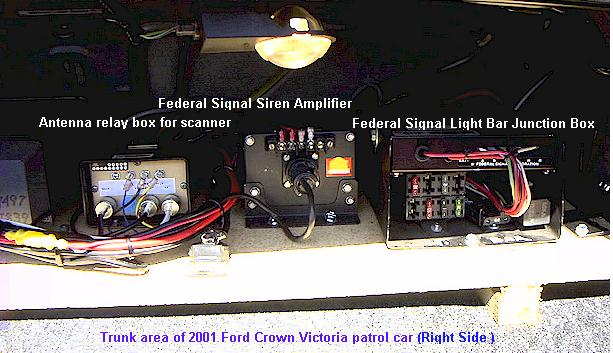
Shown below is a wall display showing the total inside wiring for the 1988 GE RANGR series radios as it was in 1994, located at the Sacramento Motor Transport facility garage. Note that the scanner is somewhat unusual in that it is a Regency MX7000 series which was not normally found in CHP service. This points out the fact that in the mid 1990's, there were several varieties of scanner in use at the same time.
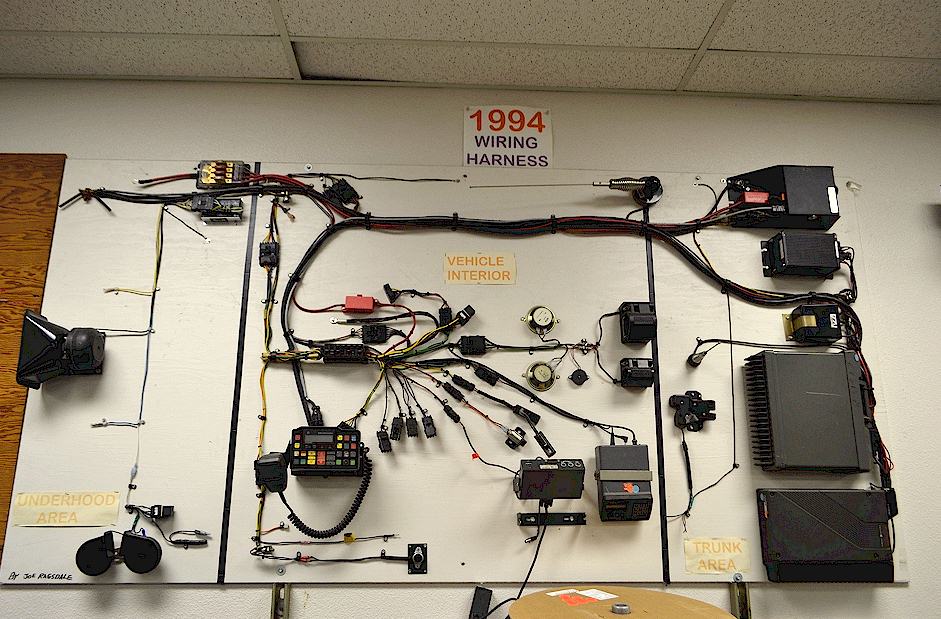
Thanks to Roger Rockstrom for the photo
HAND-HELD RADIOS
In approximately late 1988, at the same time the mobile fleet began to be modernized, the hand-held radio was upgraded to the GE MPS, a 12 channel synthesized (programmable) radio otherwise identical in appearance to the existing older 2 channel MPR unit. Some of the MPS radios featured voice encryption (scrambling); those were used for dignitary escort and were kept in Sacramento and only issued for special needs. The MPS is programmed by use of the special GE TQ- series "suitcase programmer" and an interface cable which plugs into a series of pin-sockets on the back of the radio mother-board. In late 1996, the GE MPS hand-helds were replaced by the Motorola HT-1000 portable. The HT-1000 was in service through the end of the VHF "extender" packages, and as of 2008 the CHP had begun transitioning to a 700 MHz "extender" system along with the new Rockwell Collins "CPVE" system, and awarded the first hand-held radio contract to EF Johnson.
The frequencies programmed into the MPS were as follows:
CH 1: 154.905 Simplex, PL for Car to Station (S) Extender
CH 2: 154.905 Simplex, PL for Car to Car (C) Extender
CH 3: 154.905 Simplex, No PL, Portable to Portable
CH 4: 154.920 Simplex, CLEMARS mutual aid
CH 5: 156.075 Simplex, CALCORD Mutual Aid
CH 6: 155.475 Simplex, NALEMARS National Mutual Aid
CH 7: 154.905 Simplex no PL (Portable to portable)
CH 8 through 11: Spares, usually as CH 7 above, subject to change per area office involved.
CH 12: In some applications, PL for Motorcycle Extender, otherwise as CH 1 above
By approximately 1996, the MPS had in turn been replaced by Motorola HT 1000 units, as shown below.
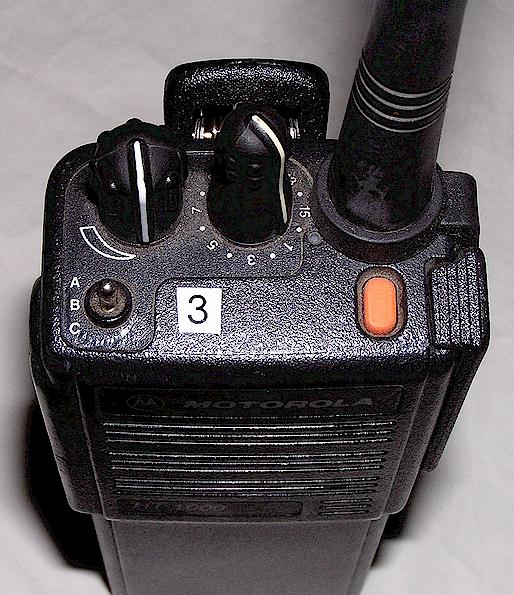
The HT1000 was a 16 channel VHF model. The channels programmed are the same as the GE MPS above except that channels 7 - 15 are spares and channel 16 is the "motorcycle repeater activate" VRS (Extender) and otherwise the same as channels 1 and 2.
THE SCANNERS
As described in the previous page, CHP in the late 1980's was using the Regency Turbo Scan TS-2:
By 1989 the TS-2 was gradually being replaced by the Uniden MR 8100, although either type could be seen through about 1993. By 1993, the MR 8100 had been installed on an almost fleet-wide basis.
By 1995, the Uniden scanners were in turn being replaced by the Bearcat 760 XLT. Note that at least in the mid-1990's Caprice vehicles, the scanner speaker line was wired to the stock car stereo in-door speakers (in series.)

RELAY BOXES
Note that the relay boxes for the scanners to use the existing communications antenna, as introduced in 1981, were still used in this era. See the previous page covering CHP radio equipment where photos of this relay box are shown.
RADAR
By the mid 1990's CHP was retiring the oldest Kustom Signals X and K band equipment, where used, and had replaced it with Kustom Signals Hawk (modified and unmodified) and Golden Eagle equipment. The Golden Eagle radar is a Ka-Band unit and Kustom Signals manufactured the CHP version specially for the State of California. See photos below. The Golden Eagle equipment was replaced in the very late 1990's by the Stalker equipment, which is still standard as of 2011. Vehicles in the 1990's could have been found with either the Hawk or the Eagle radar equipment.
Photos by eBay seller "lonym"

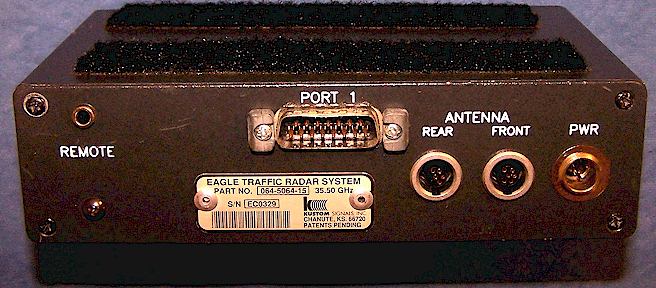
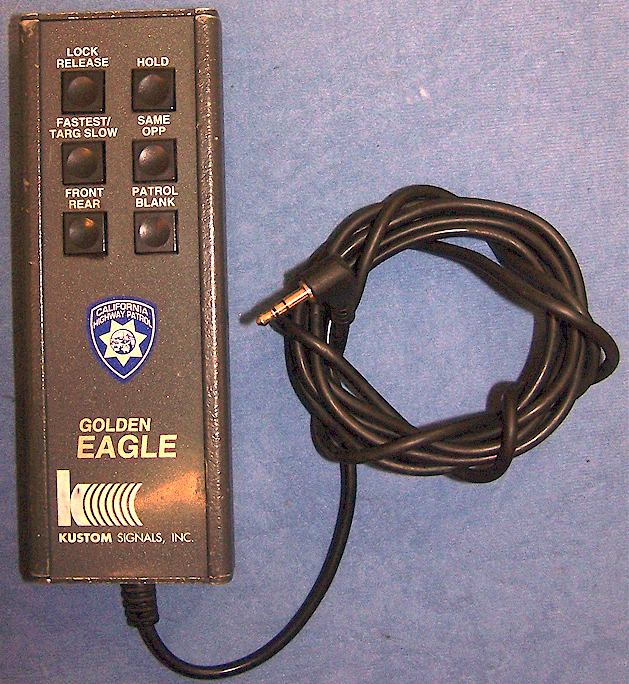
THE MOBILE "EXTENDER" Equipment
The VHF 154.905 MHz portable-to-car equipment was upgraded to a second generation GE Executive II unit when the GE RANGR radios were put into use. These appear physically identical to the original MVR16 unit, except that the logic circuitry is modernized and the model number changed to RVR16HP. The original 1981 design "MVR" is shown first below. The newer "RVR" unit is of identical external appearance, only the logic boards are different.
Final version "RVR" Unit:
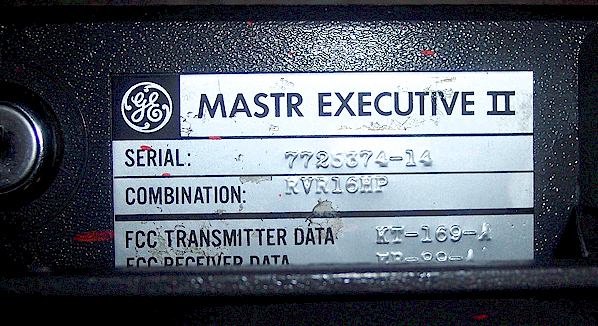
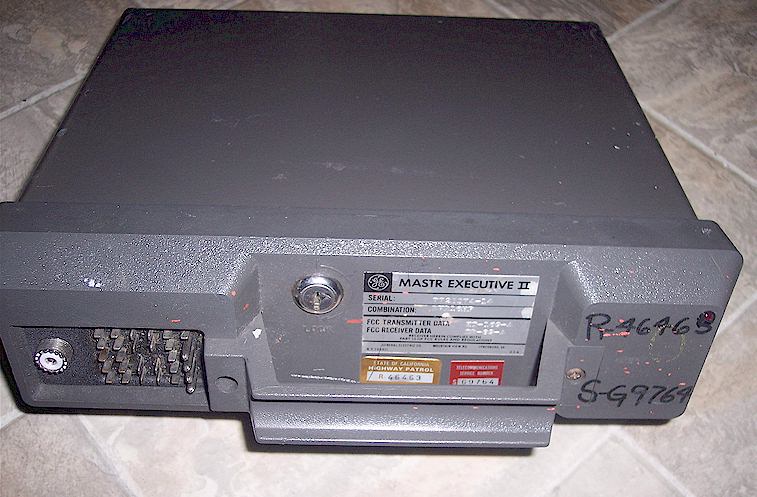
Photos poached from eBay (!)
By the late 1990's CHP had begun to use the Pyramid brand mobile repeater. These are shown on the next page, in the CHP 2001 section. The CHP did not completely retire these GE units at the time, they were gradually phased out and some were still in use as late as 2010.
ANTENNAS
The cellular modem and "extender" repeater antennas were standard Antenna Specialists on-glass models, mounted on the rear windshield, at the center and far right.
The low band two-way radio antenna, formerly a ball and spring type mounted on a rear quarter panel, was changed beginning in late 1995 to a roof mounted loaded quarter-wave antenna, which by the late 2000's was replaced with a wider-bandwidth model, which has itself been replaced again by a wider bandwidth model (2010) to allow 35-46 MHz coverage, accommodating the new channels on 35 and 45 MHz.
Here is an example of the antennas found on a 1995 Caprice with all options:
Main two-way antenna: Antenex C40 /MBDPST (Roof, 12.5" from rear glass trim molding)
Extender antenna, on glass: Allen Telecom AP-153 (Center rear glass)
K9 remote control antenna: Antenex A155S /MB8UM14 (this was the remote to release the dog from the rear seat in K9 cars), trunk lid center
CB antenna (when requested): Fire Stik FST-FS4 on Allen Telecom ASP-3 Ball Mount, right rear exterior quarter panel
Computer modem antenna: Allen Telecom APG 852.3T
Note: The 1995 Motor Transport booklet for the Caprice also shows an antenna appearing to be an 800 MHz antenna of the same type as the computer modem antenna, on the left rear glass edge, described as "Vehicle Locator Antenna." I am not sure what this is, let me know if you know.
IN-VEHICLE COMPUTERS
The use of in-vehicle computers did not begin on any meaningful scale until approximately 1996, when the antennas for the low band radio began being moved to the roof primarily to avoid interference to and by the computer. More data can be found on the CHP 2001 page. As computers were installed in the cars, the shotguns began to be removed from the passenger compartment and were placed in the trunk.
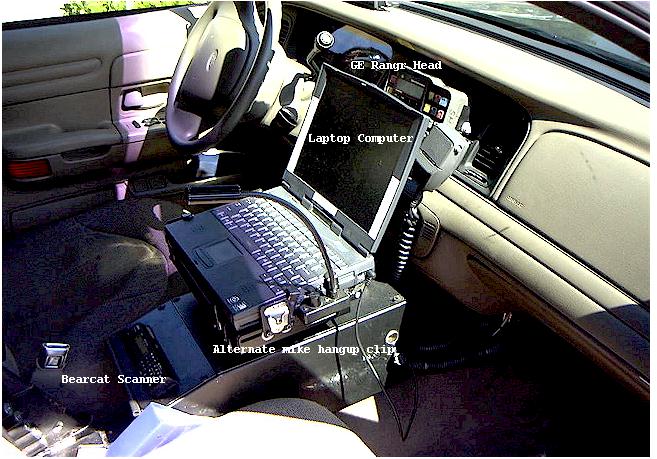
COMPUTERS:
The computers were "off the shelf" laptops from a number of manufacturers. The CHP Motor Transport manuals show Grid and NEC laptops in use, and Gateway models were also seen in use during the late 1990's.
"CELLULAR" MODEMS:
The serial port of the laptop computer was wired to a cable which began to be installed in patrol vehicles in 1995, and which ran to the trunk area where it was wired to a "cellular" wireless modem. In this case, "cellular" means the 1G GMSK "Mobitex" format data plans offered by Cingular Wireless (in California) for the first generation Blackberry and Palm PDA's, which operated at 900 MHz.
1995 era manuals indicate that the first of such modems were Ericsson C719/M units, which were in turn connected to a glass mounted antenna on the rear windshield at the passenger side. Slightly later, other modems came into use such as Motorola versions (model # unknown - need this data!) The particular modem in use depended upon the area the car was assigned to. Coverage via these modems was not by any means universal and it was not until approximately 2000 that laptops would become installed in all cars.
The Ericsson modem was mounted underneath the wooden mounting board in the trunk in the Caprice vehicles, and (apparently) in the upper right trunk area of the late 1990's and newer cars.
These first generation "Blackberry" modems would be replaced by GSM modems in the 2002 era, such as the Sierra Wireless model shown on the CHP 2009 pages.
Ericsson C719/M:
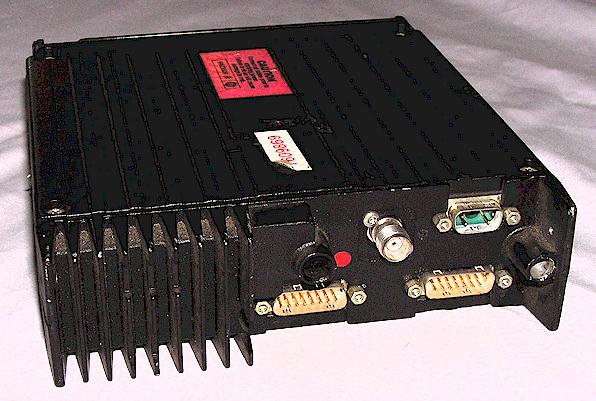
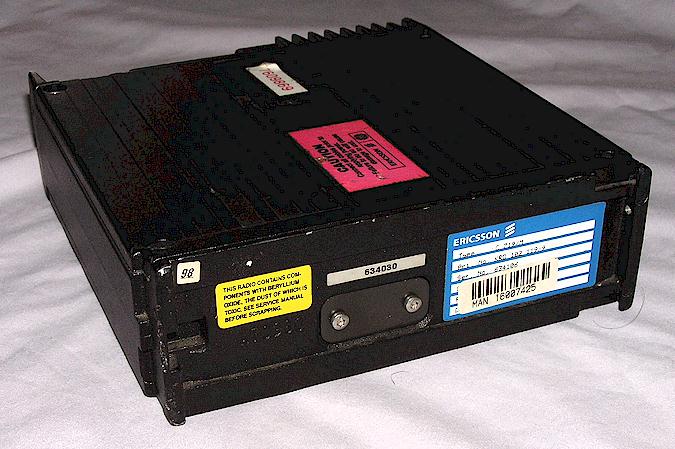
SIRENS AND LIGHTING
While these pages are intended to cover the radio communications equipment, some data on the sirens and emergency lighting can be mentioned. The 1988 and newer fleet adopted the Federal Signal PA500 siren unit and the first emergency equipment controller used when the GE S810 control head was introduced was the Code 3 Model 415 Cal control shown below. This box controlled the three PAR 46 lamps on the rear package shelf or the Federal Signal Jetsonic light bars. The Code 3 controllers were replaced starting in approximately 1992 as cars were run out, with new vehicles after that date having the CHP-made sheet metal "containment box" with Federal Signal components inside, for use with the Federal Signal Vision light bar or deck lights. (Thanks to Ed Ramsey for this information)
CODE 3 BOX PRIOR TO 1992:
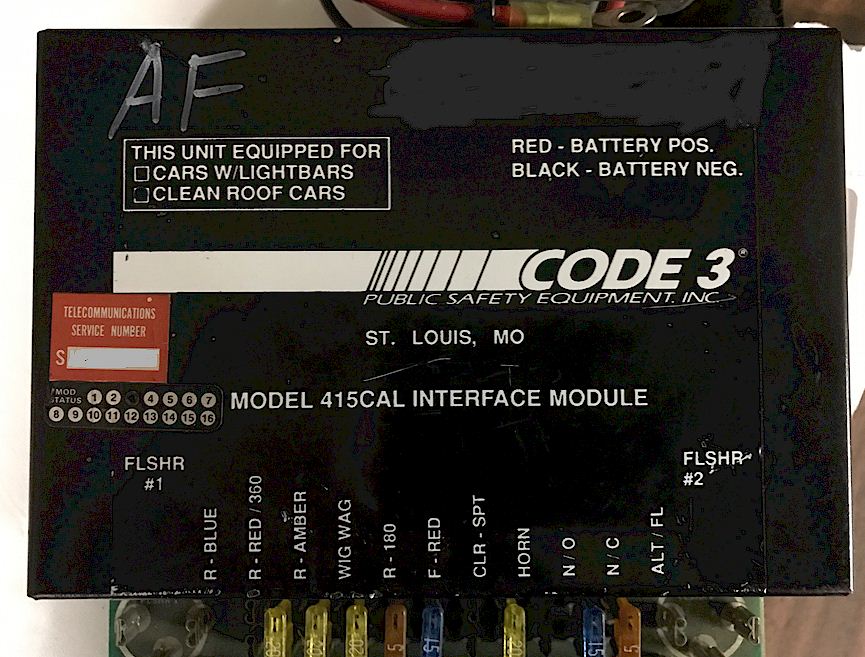
Courtesy of Ed Reynolds, I have a pdf scan of the 1992 Software CHP501D notebook on how to use the GE S810 Head with the Code 3 Interface Module shown above, for the rear deck lamps "slicktop" cars. E-mail me if you would like a copy. Make sure your mailbox can handle an 11 Meg attachment.
CONTAINMENT BOX w/ FEDERAL SIGNAL CONTROLLER, after 1992
After 1992 the vehicles used a thick sheet metal box called the "Containment Box," which housed a Federal Signal controller, some flasher relays and fuses. There were two containment boxes: "Slick top" or "Deck Lights" and "Light Bar." "Light Bar" of course was for the Federal Signal Vision™ light bar. Other photos of the containment box assemblies can be seen on the "CHP 2001" pages. There were several variations of the controller used in the containment box over the years. One example is shown below.
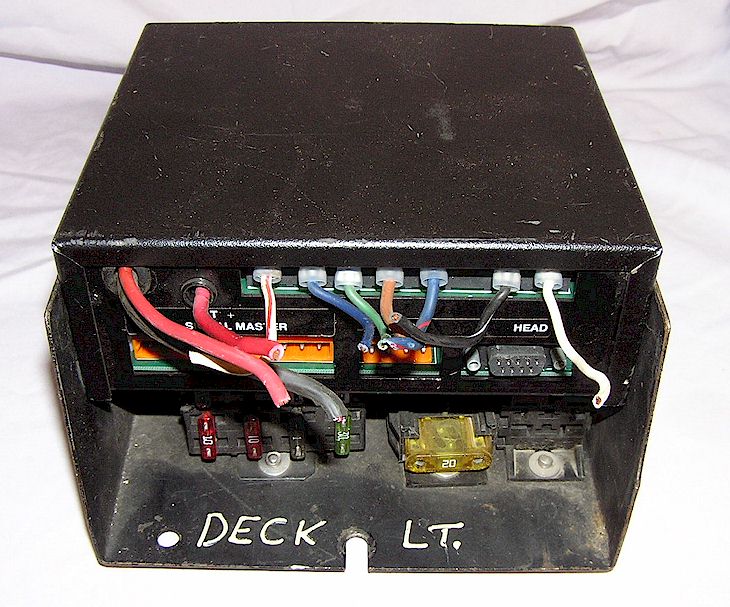
CLICK HERE FOR THE PAGE DESCRIBING CONTAINMENT BOXES
The siren amplifier unit is shown below, PA500M - CHP2. Presumably there was a PA500M-CHP1. The -CHP2 was in use in 1989 to at least 2010...
Photos courtesy Roger Rockstrom
Note that the CHP control heads had a personality change feature which allowed selection of outputs called "Serial," "Parallel," "Tandem" and "Motorcycle." Apparently after 1992 the "Tandem" mode was programmed, but the early models required the "Parallel" mode for the Code 3 Interface Box..
NOTE: THE FATE OF THE 1977 MOTOROLA/GE RADIO FLEET:
In late 1987, GE did not accept the Motorola Micor radio fleet as trade-in credit for the new RANGR radios. Instead, CHP participated in a program where most electronic equipment was sent to the State Office of Emergency Services in Sacramento where it was warehoused and recycled. By recycling, it is meant that city, county and state agencies as well as the Red Cross, Explorer Scouts and so forth could draw whatever they needed from this warehouse essentially without charge. The GE RANGR radio changeover was apparently complete by about 1990 although as mentioned above, there is evidence the Micor equipment was for some reason still being installed in Mustang cars as late as 1989. Thus, the 1977 fleet was saved from destruction, although pieces of it have been scattered throughout the State of California and beyond as a result.
Concluding Notes: Every time I think I have all the details straight, I learn something which throws me a curve, or I find new material, and it's then necessary to re-write part of this page. Sometimes inaccurate information creeps in, an unavoidable aspect of a project this large, which is an ongoing effort of refinement.. So don't be surprised if you check back later and find that some of the information has changed. Please also note that the dates shown for when equipment was put into service are not absolute as far as when the previous equipment was removed from service. In other words, it took anywhere up to three or four years to completely replace the entire radio fleet, and was done as each new vehicle left Sacramento. Some installations were modified in the field so that they were not technically the same as the way they left Sacramento. In a system as large as this, there will always be variations, and always exceptions to the "general rule."
NOTE TO POLICE CAR RESTORERS: It has come to my attention that certain websites may contain photos of "restored" CHP cars and motorcycles containing bogus radio installations. These cars and cycles are also occasionally offered on eBay and at collector auctions as "totally authentic," which they are not. It is suggested that before you waste a lot of money purchasing one of these fakes, or equipment which is represented to be genuine, do your homework! The Motor Transport Installation Guide manuals and sheets are excellent for this if you can get your hands on one.
This page created by Geoff Fors, Monterey California. Not officially sponsored by the State of California or the California Highway Patrol. If you have any additional information, historical data or photos, or have any suggestions, please do contact me by e-mail, at geoff @wb6nvh.com. I hope to find others who are also interested in preserving this history. I am always looking for CHP radio equipment, parts, manuals, etc. for this "virtual museum" and my collection, particularly the pre-1960 equipment, as well as almost any ancient land mobile radio equipment and documentation. I am still trying to find the RCA radio drawers for the CHP-Special Super Carfone and Super Fleetfone 1960's radios, motorcycle equipment pre-1978, and control heads for the Philco prewar police receivers and the RCA CMV-3 "Fleetfone." Don't let history wind up in the landfill ! I also need photos from the 1970's and earlier (full credit will be given) especially of the car interiors, people involved in CHP radio systems, and of the equipment in actual use.
THIS PAGE CONTINUED, 2001 AND LATER
Ed. 7/4/2021 © Geoffrey C. Fors, All rights reserved